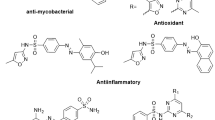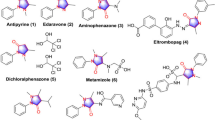Abstract
We designed and developed a novel series of bioactive disperse dyes by conjugation of spirocyclic 2-thiopyrimidine scaffold with aryl or sulfa drug moieties in the same construct through azo linker to take advantage of the bioactive character of both motifs. The target molecules were simply approached on a gram scale via the diazocoupling of spirocyclic 2-thiouracil 1 with aryl diazonium chloride derivatives to afford the heterocyclic azo-disperse dyes 4a–e in excellent yield. These azo dyes were effectively utilized to make pastes for silkscreen printing of polyester fabrics. The color characteristics of the dyes and their fastness properties including washing, rubbing, perspiration, sublimation, and light fastness were also investigated. The antimicrobial activity of the produced dyes 4a–e was evaluated against some Gram-positive and Gram-negative bacteria, and the results revealed that 4d was more active than the standard drug cefoperazone against the Gram-positive bacteria S. aureus. The antibacterial efficacy of the treated fabrics has also been investigated revealing that the dyed fabric 4b was found to have a potent inhibition on B. cereus (93 %), and against E. coli with a reduction of (90%).
Similar content being viewed by others
References
G. M. Malik and S. K. Zadafiya, Chem. Sin., 1, 15 (2010).
G. A. M. Nawwar, K. S. A. Zaher, E. Shaban, and N. M. A. El-Ebiary, Fiber. Polym., 21, 1293 (2020).
E. Shaban, S. H. Nassar, S. Shabban, and H. E. Gaffer, Egypt. J. Chem., 60, 73 (2017).
K. M. Hassan, S. A. S. ElKhabiery, G. M. ElHaddad, S. H. Shokair, and I. E. ElSayed, J. Iran. Chem. Soc., 19, 147 (2022).
A. Gičević, L. Hindija, and A. Karačić, “International Conference on Medical and Biological Engineering”, pp.581–587, doi: https://doi.org/10.1007/978-3-030-17971-7_88, 2019.
J. Mokhtari, A. Shams-Nateri, and P. Ferdosi, Fiber. Polym., 15, 1369 (2014).
R. Bentley, J. Ind. Microbiol. Biotechnol., 36, 775 (2009).
Y. Guo, H. Lee, and H. Jeong, Prog. Mol. Biol. Transl. Sci., 171, 61 (2020).
G. Plosker and K. Croom, Drugs, 65, 2591 (2005).
N. Sala, G. Prats, M. Villabona, I. Gallardo, T. Hamdan, R. O. Al-Kaysi, J. Hernando, and G. Guirado, Dyes Pigm., 153, 160 (2018).
P. Cui, X. Li, M. Zhu, B. Wang, J. Liu, and H. Chen, Eur. J. Med. Chem., 127, 159 (2017).
A. S. Chaudhary, J. Jin, W. Chen, P. C. Tai, and B. Wang, Bioorg. Med. Chem., 23, 105 (2015).
M. S. Mohamed, S. M. Awad, and N. M. Ahmed, Acta Pharm., 61, 171 (2011).
K. Cheng, Q.-Z. Zheng, Y. Qian, L. Shi, J. Zhao, and H.-L. Zhu, Bioorg. Med. Chem., 17, 7861 (2009).
A.-A. S. El-Etrawy and F. F. Sherbiny, J. Mol. Struct., 1232, 129993 (2021).
A. S. Chaudhary, W. Chen, J. Jin, P. C. Tai, and B. Wang, Future Med. Chem., 7, 989 (2015).
R. M. Abd El-Aal and M. Younis, Dyes Pigm., 60, 205 (2004).
M. Ma, Y. Sun, and G. Sun, Dyes Pigm., 58, 27 (2003).
P. Sah, J. Oneto, and H. Sah, Arzneimittel-Forschung, 10, 533 (1960).
E. M. Hussein, Monatsh. Chem., 144, 1691 (2013).
TS EN ISO, “Textiles-Tests for Colour Fastness-Part C06: Color Fastness to Domestic and Commercial Laundering (TS EN ISO 105-C06)”, 2012.
ISO 105-E04:2008, “Textiles — Tests For Colour Fastness — Part E04: Colour Fastness to Perspiration”, 2008.
U. Nimkar and R. Bhajekar, Colorage, 43, 135 (2006).
ISO 105-B02:2013, “Textiles — Tests for Colour Fastness — Part B02: Colour Fastness to Artificial Light: Xenon Arc Fading Lamp Test”, 2013.
ISO 105-X12:2001, “Textiles — Tests for Colour Fastness — Part X12: Color Fastness to Rubbing”, 2001.
B.S 1006:1990, “Standard Methods for the Determination of the Colour Fastness of Textiles and Leather”, 5th eds., 1991.
J. Tamokou, A. Mbaveng, and V. Kuete in “Medicinal Spices and Vegetables from Africa” (V. Kuete Ed.), p.207, Elsevier, 2017.
J. M. Jabar, A. I. Ogunmokun, and T. A. A. Taleat, Fash. Text., 7, 1 (2020).
M. R. Luo, “Encyclopedia of Color Science and Technology”, Springer, New York, NY, 2016.
M. Sadeghi-Kiakhani and S. Safapour, Color. Technol., 131, 142 (2015).
S. M. Al-Mousawi, M. A. El-Apasery, and M. H. Elnagdi, Molecules, 18, 11033 (2013).
Y. M. Elkholy, M. H. Helal, and A. W. Erian, Pigment Resin Technol., 30, 168 (2001).
P. J. Shah, H. S. Patel, and B. P. Patel, J. Saudi Chem. Soc., 17, 307 (2013).
T. D. Brock, M. T. Madigan, J. M. Martinko, and J. Parker, “Brock Biology of Microorganisms”, Pearson Prentice-Hall, Upper Saddle River, NJ, 2003.
Author information
Authors and Affiliations
Corresponding authors
Ethics declarations
The authors declare that there is no conflict of interest.
Supporting information
12221_2022_4032_MOESM1_ESM.pdf
Design, Synthesis, and Antibacterial activity of Spiropyrimidinone Derivatives Incorporated Azo Sulfonamide Chromophore for Polyester Printing Application
Rights and permissions
About this article
Cite this article
Ragab, S.S., Sweed, A.M.K., Hamza, Z.K. et al. Design, Synthesis, and Antibacterial Activity of Spiropyrimidinone Derivatives Incorporated Azo Sulfonamide Chromophore for Polyester Printing Application. Fibers Polym 23, 2114–2122 (2022). https://doi.org/10.1007/s12221-022-4032-4
Received:
Revised:
Accepted:
Published:
Issue Date:
DOI: https://doi.org/10.1007/s12221-022-4032-4




